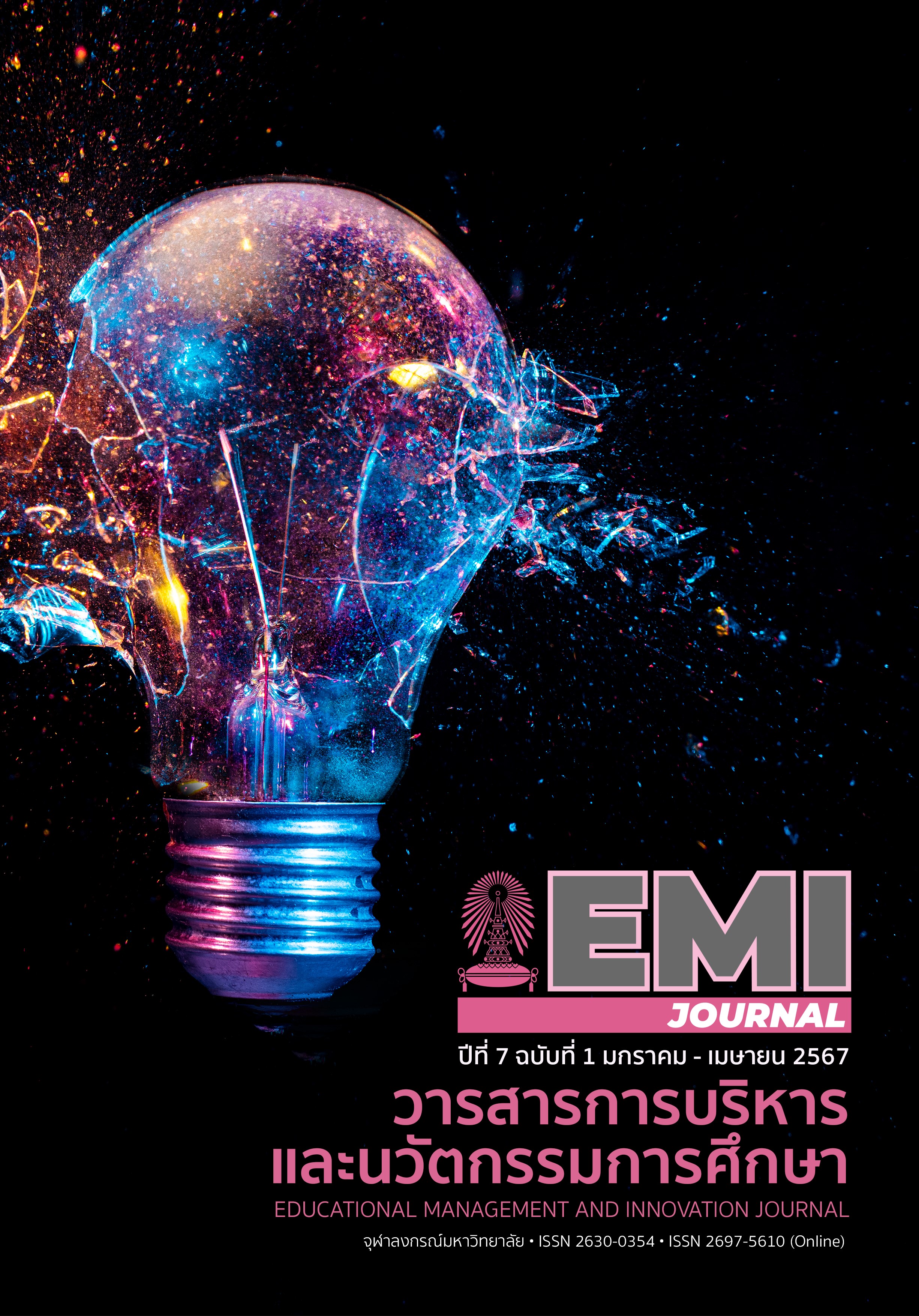The Priority Needs and Development Methodologies in Blended Teaching Competencies of Private Primary School Teachers in Bangkok
ความต้องการจำเป็นและวิธีการพัฒนาสมรรถนะการสอนแบบผสมผสานของครูโรงเรียนประถมศึกษาเอกชนในกรุงเทพมหานคร
คำสำคัญ:
ความต้องการจำเป็น , สมรรถนะการสอนแบบผสมผสาน , วิธีการพัฒนาสมรรถนะครู , โรงเรียนประถมศึกษาเอกชนบทคัดย่อ
ปัจจุบันนวัตกรรมและเทคโนโลยีก่อให้เกิดการเปลี่ยนแปลงทางสังคมอย่างรวดเร็ว ส่งผลให้รูปแบบการสอนเปลี่ยนไป ครูจึงมีความจำเป็นที่จะต้องพัฒนาความรู้ ทักษะ เจตคติ และจัดการเรียนการสอนที่เหมาะสมกับบริบทการเปลี่ยนแปลง งานวิจัยนี้จึงศึกษาความต้องการจำเป็นและวิธีพัฒนาสมรรถนะการสอนแบบผสมผสานของครูโรงเรียนประถมศึกษาเอกชนในกรุงเทพมหานคร โดยมีผู้ให้ข้อมูล คือ ผู้อำนวยการโรงเรียน รองผู้อำนวยการโรงเรียน หัวหน้ากลุ่มสาระ และครูผู้สอนระดับประถมศึกษา รวมทั้งสิ้น 211 คน เก็บรวบรวมข้อมูลโดยใช้แบบสอบถาม และวิเคราะห์ข้อมูลโดยการหาค่าความถี่ ค่าร้อยละ ค่าเฉลี่ยเลขคณิต ส่วนเบี่ยงเบนมาตรฐาน และค่าดัชนีความต้องการจำเป็น ผลการวิจัยโดยภาพรวมพบว่า สมรรถนะการสอนแบบผสมผสานของครูโรงเรียนประถมศึกษาเอกชนในกรุงเทพมหานคร มีสภาพปัจจุบันและสภาพที่พึงประสงค์อยู่ในระดับมาก โดยมีความต้องการจำเป็นในด้านทักษะทางเทคนิคสูงที่สุด รองลงมาคือ ด้านคุณลักษณะ ด้านทักษะการปรับตัว และด้านกรอบความคิด ตามลำดับ ซึ่งวิธีการพัฒนาครูที่มีความถี่สูงที่สุด คือ การพัฒนาในระหว่างปฏิบัติงานที่ใช้การพัฒนาด้วยการสอนงาน รองลงมาคือ การพัฒนานอกเวลาปฏิบัติงานที่ใช้การพัฒนาตนเอง ตามลำดับ ผลการวิจัยดังกล่าวแสดงให้เห็นถึงความสำคัญของนโยบายส่งเสริมความรู้และความสามารถในการใช้เทคโนโลยี เพื่อสนับสนุนการเรียนการสอนในยุคศตวรรษที่ 21
Downloads
เอกสารอ้างอิง
Areekul, C. (2019). Alternative education: the important learning model for generation alpha. Journal of MCU Social Science Review, 8(3), 270-283. [In Thai]
Arnesen, K. T., Graham, C. R., Short, C. R., & Archibald, D. (2019). Experiences with personalized learning in a blended teaching course for preservice teachers. Journal of Online Learning Research, 5(3), 275-310.
Bowchamchoy, K., & Kamhaengkit, R. (2019). Learning achievement from blended learning in information searching and academic writing of undergraduate students at Princess of Naradhiwas University. Princess of Naradhiwas University Journal of Humanities and Social Science, 6(1), 66-77. [In Thai]
Castetter, W. B., & Young, I. P. (2000). The human resource function in Education Administration
(7th ed.). Pretice-Hall.
Chantem, S. (2010). Hybrid Learning with the innovation of teaching accounting subjects in the
st century. 21: Case studies of the University of the Thai Chamber of Commerce. [In Thai]
Dessler, G. (2013). Human Resources Management (13th ed.).
Dexter, S. (2018). The role of leadership for information technology in education. In J. Voogt, G. Knezek, R. Christensen, & K.-W. Lai (Eds.), Second handbook of information technology in primary and secondary education (pp. 483-498). Cham, Switzerland: Springer.
Gasiewski, J. A., Eagan, M. K., Garcia, G. A., Hurtado, S., & Chang, M. J. (2012). From Gatekeeping to Engagement: A Multicontextual, Mixed Method Study of Student Academic Engagement in Introductory STEM Courses. Research in Higher Education, 53(2), 229-261. https://doi.org/10.1007 /s11162-011-9247-y
Graham, C. R., Borup, J., Short, C. R., & Archambault, L. (2019). K-12 blended teaching: A guide to personalized learning and online integration. http://edtechbooks.org/k12blended
Gulosino, C., & Miron, G. (2017). Growth and performance of fully online and blended K-12 public schools. Education Policy Analysis Archives, 25(0), 124. https://doi.org/10.14507/epaa.25.2859
Helane, S. (2021). Implementing Technology in the Classrooms to Increase Students’ Engagement and Academic Achievement [Master’s thesis, Trinity Christian College].
Jongdern, A. (2017). Academic administration strategy of private school under office of private education satun province [Master’s thesis, Haiyai University]. [In Thai]
Kanjanawasee, S. (2013). Traditional test theory (7th ed.). Bangkok: Chulalongkorn University Printing House. [In Thai]
Kiviniemi, M. (2014). Effects of a blended learning approach on student outcomes in a graduate-level public health course. BMC medical education, 14, 47. https://doi.org/10.1186/1472-6920-14-47
Kulophas, D., & Kim, M. (2020). How “Thailand 4.0” principals applied leadership and technology towards teacher learning: Three case studies. Kasetsart Journal of Sicial Sciences, 41(3), 614-619. http://dx.doi.org/10.34044/j.kjss.2020.41.3.25
Kustec, S. (2021). Council Recommendation on blended learning approaches for high-quality and inclusive primary and secondary education. https://eur-lex.europa.eu/legal-content/EN/TXT/ PDF/?uri=CELEX:32021H1214(01)
Lalognum, N. (2018). A development of blended instructional model by creative media of students and cooperative learning for practicing in using educational technology equipment for undergraduate in educational technology. Journal of Educational, Burapha University, 29(2), 123-141. [In Thai]
Masena, C. (2016). Educational human resource development in the next decade. Buabundit Journal of Educational Administration, 16(1), 9-16. [In Thai]
Narintarangkul, N. A. S. (2019). Human Resource Management. Chulalongkorn University Press. [In Thai]
Office of the Private Education Commission. (2013). Strategic plan to promote private education in 2013-2017. Office of the Permanent Secretary, Ministry of Education. [In Thai]
Oliver, K. M., & Stallings, D. (2014). Preparing teachers for emerging blended learning environments. Journal of Technology and Teacher Education, 22, 57-81. http://www.learntechlib.org/c/JTATE
Oliver, W. L. (2014). Oliver’s framework for blended instruction. http://blendedpractice.com/wp-content/uploads/2015/11/Olivers-Blended-Framework-for-Instruction.pdf
Paje, S. (2010). Professional development of teachers to the educational reform era in the second decade in the academic seminar on the whole system teacher development according to strategies of educational reform Phrae. [In Thai]
Powell, A., Rabbitt, B., & Kennedy, K. (2014). iNACOL blended learning teacher competency framework. https://www.inacol.org/wp-content/uploads/2014/10/iNACOL-Blended-Learning-Teacher-Competency-Framework.pdf
Short, C. R., Graham, C. R., & Sabey, E. (2021). K-12 blended teaching skills and abilities: An analysis of blended teaching artifacts. Journal of Online Learning Research, 7(1), 5-33.
Sirithadakunlaphat, S. (2018). Effect of the blended learning for enhancing attitudes and among achievement of future teachers towards inclusive education. Journal of Research and Development in Special Education, 7(2), 92-106. [In Thai]
South, J., & Stevens, K. (2017). Reimagining the Role of Technology in Education: 2017 National Education Technology Plan Update. https://tech.ed.gov/files/2017/01/NETP17.pdf
Tayag, J. R. (2020). Pedagogical support for blended learning classrooms: interfacing teacher and student perspectives. Universal Journal of Educational Research, 8(6), 2536-2541. https://doi.org/10.13189 /ujer.2020.080637
Thienthong, T. (2023). Policy and focus of the Ministry of Education in fiscal year 2023. [In Thai]
Voraprawat, O. (2021). A state of learning organization of private educational institutions under the private education commission of Muang district, Nakhon Sawan province [Master’s thesis, Naresuan University]. [In Thai]
Wongwanit, S. (2016). Needs Assessment Research. Chulalongkorn University Printing Press. [In Thai]
Yamane, T. (1973). Statistics: An Introductory Analysis. New York: Harper and Row.
ดาวน์โหลด
เผยแพร่แล้ว
ฉบับ
ประเภทบทความ
สัญญาอนุญาต
ลิขสิทธิ์ (c) 2024 วารสารการบริหารและนวัตกรรมการศึกษา

อนุญาตภายใต้เงื่อนไข Creative Commons Attribution-NonCommercial-NoDerivatives 4.0 International License.



